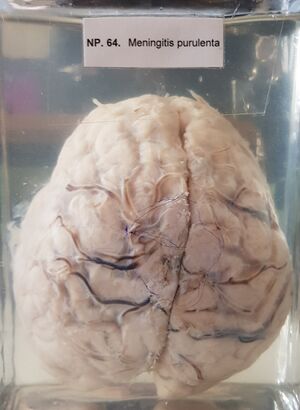29. Purulent meningitis: Difference between revisions
No edit summary |
No edit summary |
||
| (One intermediate revision by the same user not shown) | |||
| Line 1: | Line 1: | ||
'''Organ''': Brain + meninges | '''Organ''': Brain + meninges | ||
'''Description''': | '''Description''': The meninges are the thin fibrous layer on top of the brain. The veins on the surface of the brain are dilated. In the middle of the preparation, under the meninges can some white fluid be seen. | ||
The meninges are the thin fibrous layer on top of the brain. The veins on the surface of the brain are dilated. In the middle of the preparation, under the meninges can some white fluid be seen. | |||
'''Diagnosis''': Purulent meningitis | '''Diagnosis''': Purulent meningitis | ||
| Line 9: | Line 7: | ||
'''Causes''': | '''Causes''': | ||
* In infants: E. coli | * In infants: E. coli | ||
* In other age groups meningococcus or pneumococcus | * In other age groups: meningococcus or pneumococcus | ||
'''Theory''': | '''Theory''': | ||
Purulent meningitis is a type of purulent acute inflammation. It’s also an empyema because the exudate is inside the subarachnoid space, which is a normal anatomical space. The exudate is comprised of pus comprised of neutrophils, bacteria and dead tissue. The veins are dilated because of the inflammation. | Purulent meningitis is a type of purulent acute inflammation. It’s also an empyema because the exudate is inside the subarachnoid space, which is a normal anatomical space. The exudate is comprised of pus comprised of neutrophils, bacteria and dead tissue. The veins are dilated because of the inflammation. Symptoms include severe headache, fever, stiff neck, photophobia, altered mental status, and sepsis. If the purulent meningitis is caused by the meningococcus bacteria and the patient develops sepsis the patient may develop a complication called Waterhouse-Friederichsen syndrome (WFS). The endotoxins produced by the meningococcus causes haemorrhagic necrosis of the adrenal glands. The glands cannot produce hormones anymore, and the lack of aldosterone production disrupts the fluid and ion regulation in the body which can cause death.[[File:Purulent meningitis prep.jpg|center|thumb|The pen marks the area of the pus.]] | ||
Symptoms include severe headache, fever, stiff neck, photophobia, altered mental status, and sepsis. | |||
If the purulent meningitis is caused by the meningococcus bacteria and the patient develops sepsis the patient may develop a complication called Waterhouse-Friederichsen syndrome (WFS). The endotoxins produced by the meningococcus causes haemorrhagic necrosis of the adrenal glands. The glands cannot produce hormones anymore, and the lack of aldosterone production disrupts the fluid and ion regulation in the body which can cause death. | |||
[[File:Purulent meningitis prep.jpg|center|thumb| | |||
[[Category:Pathology 1 - Macropreparations]] | [[Category:Pathology 1 - Macropreparations]] | ||
Latest revision as of 10:24, 5 July 2024
Organ: Brain + meninges
Description: The meninges are the thin fibrous layer on top of the brain. The veins on the surface of the brain are dilated. In the middle of the preparation, under the meninges can some white fluid be seen.
Diagnosis: Purulent meningitis
Causes:
- In infants: E. coli
- In other age groups: meningococcus or pneumococcus
Theory:
Purulent meningitis is a type of purulent acute inflammation. It’s also an empyema because the exudate is inside the subarachnoid space, which is a normal anatomical space. The exudate is comprised of pus comprised of neutrophils, bacteria and dead tissue. The veins are dilated because of the inflammation. Symptoms include severe headache, fever, stiff neck, photophobia, altered mental status, and sepsis. If the purulent meningitis is caused by the meningococcus bacteria and the patient develops sepsis the patient may develop a complication called Waterhouse-Friederichsen syndrome (WFS). The endotoxins produced by the meningococcus causes haemorrhagic necrosis of the adrenal glands. The glands cannot produce hormones anymore, and the lack of aldosterone production disrupts the fluid and ion regulation in the body which can cause death.

